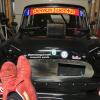
Clr How To Use?
#1

Posted 03 July 2018 - 10:01 AM
Reading other threads the suggestion is to use CLR, so how much do I need and how long do I run it for?
I can get a CLR stain remover from Screwfix https://www.screwfix...over-1ltr/8679f
Would a quantity of this suffice or do I simply change the radiators?!
Thanks again folks
#2

Posted 03 July 2018 - 10:25 AM
#3

Posted 03 July 2018 - 10:37 AM
It was me I think who first suggested this on the forum as I've used the product for this purpose for a number of years without problem and usually, with good success,,,,
however,,,,,, a caveat,,,,,,,
It appears they have changed it in recent times and it's a product that not recommended to clean (decorative) cast Iron or cooling systems with. In regards to the Cast Iron, it seems what they are getting at here is that it will dissolve rusted cast iron and frankly, that's what we want, however, for decorative cast iron, it's more desirable to neutralise the rust so the item doesn't loose it's appearance. In regards to cooling systems, their concern is that it may not be flushed out when done and I think the answer to that is quite obvious.
I can get it in 2 litre containers and that's how much I put in and top the rest off with tap water. I usually leave it in for a week, but have left it much longer. A few heat cycles helps too, mainly to circulate it through the system - be sure you have the heater set to hot too.
Another small caveat,,,,
If the system is oily or greasy, then CLR is not likely to work too well, if at all. Best degrease the system first and dish washer machine powder can be good for this, but don't leave it in too long (15 - 20 mins should do it) and be sure to flush the system really well after, really really well as this could do damage to your cooling system.
If the jacket in the block and head is rusty, then CLR I've found to be the magic for that.
#4

Posted 03 July 2018 - 10:50 AM
Best thing is to take the rad out, turn the bottom hose 180° and fill the engineblock with the clr mix. Clr and lead solder dont mix very well in my experience.
Dusky, respectfully mate, I'd suggest there was something else to this. Given what CLR is specifically made for (Drain Cleaner among other things), I think they'd find themselves in a world of trouble if it reacted with Lead or Tin / Lead Solder. Many of our older and also current coastal properties have Copper Drain Pipes that are soft soldered. Common in the UK too I believe, along with Cast Brass and Cast Iron.
#5

Posted 03 July 2018 - 10:54 AM
It was me I think who first suggested this on the forum as I've used the product for this purpose for a number of years without problem and usually, with good success,,,,
however,,,,,, a caveat,,,,,,,
It appears they have changed it in recent times and it's a product that not recommended to clean (decorative) cast Iron or cooling systems with. In regards to the Cast Iron, it seems what they are getting at here is that it will dissolve rusted cast iron and frankly, that's what we want, however, for decorative cast iron, it's more desirable to neutralise the rust so the item doesn't loose it's appearance. In regards to cooling systems, their concern is that it may not be flushed out when done and I think the answer to that is quite obvious.
I can get it in 2 litre containers and that's how much I put in and top the rest off with tap water. I usually leave it in for a week, but have left it much longer. A few heat cycles helps too, mainly to circulate it through the system - be sure you have the heater set to hot too.
Another small caveat,,,,
If the system is oily or greasy, then CLR is not likely to work too well, if at all. Best degrease the system first and dish washer machine powder can be good for this, but don't leave it in too long (15 - 20 mins should do it) and be sure to flush the system really well after, really really well as this could do damage to your cooling system.
If the jacket in the block and head is rusty, then CLR I've found to be the magic for that.
Yet another drink I'm due you MS ?
#6

Posted 03 July 2018 - 11:18 AM
I have just used this I had previously run and flushed the engine with water many times as I was wanting to clean it out.
this made it look like I had done nothing.
http://www.theminifo...lr-alternative/
#7

Posted 03 July 2018 - 03:48 PM
Best thing is to take the rad out, turn the bottom hose 180° and fill the engineblock with the clr mix. Clr and lead solder dont mix very well in my experience.
Dusky, respectfully mate, I'd suggest there was something else to this. Given what CLR is specifically made for (Drain Cleaner among other things), I think they'd find themselves in a world of trouble if it reacted with Lead or Tin / Lead Solder. Many of our older and also current coastal properties have Copper Drain Pipes that are soft soldered. Common in the UK too I believe, along with Cast Brass and Cast Iron.
The more probable cause is an old rad with some calcium buildup plugging a pinhole :)
BUT I REFUSE TO ADMIT THAT!! ![]()
#8

Posted 03 July 2018 - 09:07 PM
#9

Posted 23 May 2019 - 10:06 AM
Thanks guys I believe that the cars have the original radiators(maybe even original heater matrix too) so will try CLR and if needs be I will replace
Did you try it? Which one did you use? Did it work?
#10

Posted 23 May 2019 - 04:31 PM
Did you try it? Which one did you use? Did it work?
Thanks guys I believe that the cars have the original radiators(maybe even original heater matrix too) so will try CLR and if needs be I will replace
Unfortunately I haven't had time, too many projects.... try the one from Sxrewfix or a 5l jug from eBay
#11

Posted 06 February 2020 - 04:42 PM
The cooling system on one of my Commer camper engines has always been a bit murky with rusty looking coolant so I did an experiment. I bought a litre of CLR from Screwfix and placed a selection of components and metals that you would expect to find in an engine in a stainless steel bowl and added a 50/50 mix of CLR and water. Every day for a week the solution was heated on a camping stove to simulate the engine running to see what happened.
Some rusty bolts, a temperature sender and a Mini thermostat housing went into the warm mix
Quite a reaction

I also added a piece of copper pipe, a piece of solder and the cast rear hinge off my Minor traveller
After a week the bits and pieces were taken out and rinsed off

Seems to be some transfer of metal from the copper to the steel

Very obvious on the bowl

The stat housing didn't seem to have suffered

You can see a bit of a tide mark on the housing but with a light wire brushing it came up shiny again

There was only surface rust on the hinge face and that came off within a day

The washers were very heavily rusted after many years under a Morris Minor wing but it came off leaving a heavily pitted surface

The soldered surface had gone matt but was still intact and flexible

The copper didn't seem to transfer onto the cast steel surface of the hinge so I would assume this wouldn't happen inside a block - but would it do any harm if it did? I wouldn't think so. And going on the condition of the copper and alloy components does this show that it is safe enough to use without having to remove the rad and stat housing?
Personally I would and probably will soon on the Commer engine if the Radflush I've just used hasn't been good enough.
1 user(s) are reading this topic
0 members, 1 guests, 0 anonymous users


















